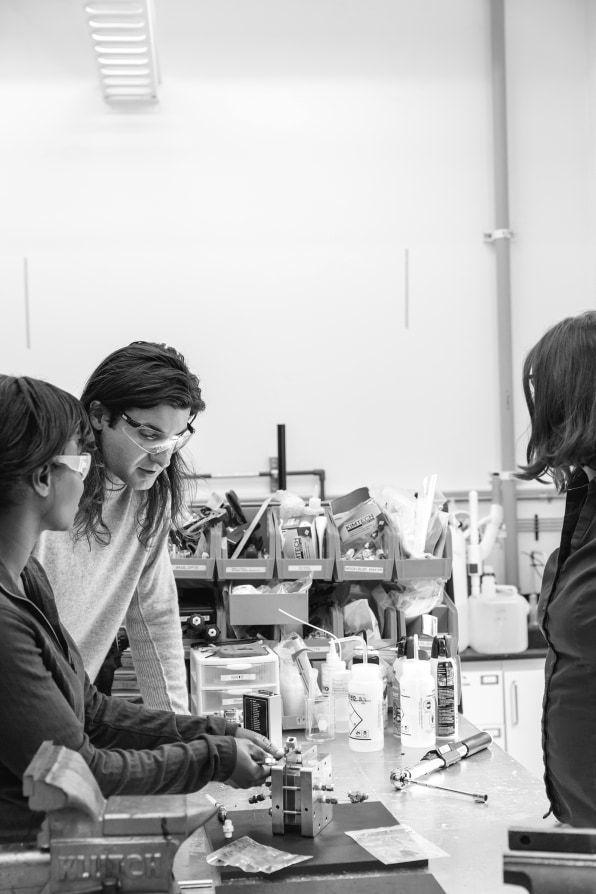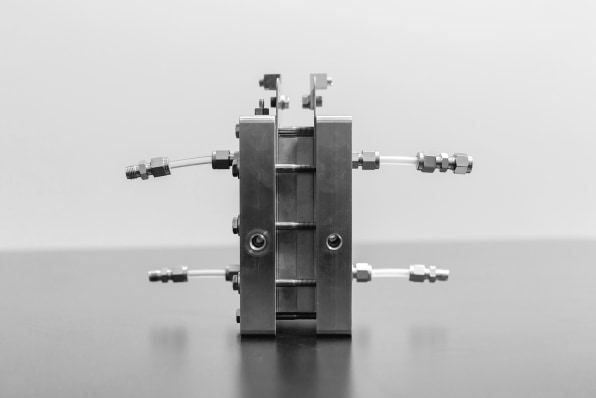Using artificial photosynthesis, Twelve creates CO2-based chemicals that can be used to make everything from car parts to laundry detergent.

From left: Kendra Kuhl, Nicholas Flanders, and Etosha Cave, founders of Bay Area startup Twelve [Photo: Courtesy Twelve]
Your home is filled with fossil fuels in the form of petrochemicals, used to make everything from the foam in your sneakers to your yoga mat, shampoo, makeup, and more—including laundry detergent, plastic packaging, aspirin, toys, appliances, clothes, speakers, bike tires, solar panels, the veneer on wooden furniture, and the paint on your walls. By one estimate, the chemicals are in at least 6,000 products; the real number is likely much larger.
In the Bay Area, a startup called Twelve is developing technology that makes some of the same chemicals from captured CO2 instead of crude oil, gas, or coal. Manufacturers can use the CO2-based chemicals in exactly the same way that they used petrochemicals. “They’ll be identical to conventional products [but] made from recycled emissions,” says Nicholas Flanders, cofounder and CEO.
The company, which just announced that it raised $57 million in Series A funding, is one of the first to commercialize a process called artificial photosynthesis. Inspired by the way plants turn CO2, water, and sunlight into carbon, the company uses renewable electricity and water to make carbon from CO2. That carbon can be turned into products like ethylene, a basic ingredient in making plastic.

“Basically, we use electricity to break apart CO2 and water,” Flanders says. “And then our catalysts, which are part of our core technology, recombine those atomic bits to make new molecules.”
Development of artificial photosynthesis technology began in universities in the 1960s, but it’s been challenging to make it feasible at an industrial scale. It’s hard to make the process energy-efficient and to make specific products; and it’s difficult to scale up the technology. In the past, scientists have used devices that convert solar energy and split water in a single cell. Twelve’s system separates the two steps, which makes the technology more efficient and scalable; the company calls its process industrial photosynthesis. The catalysts that it’s created can be used in an existing reactor that was developed for making green hydrogen, so the company doesn’t have to start from scratch with completely new machinery.
Last year, the company worked with Mercedes-Benz to make the first-ever auto part from recycled CO2. “What’s interesting is a new car contains about 300 kilograms of polymers, and pretty much all of those we can make from CO2,” Flanders says. “That’s going to be true even for an electric car.” Twelve is also working with Proctor & Gamble on CO2-made ingredients for Tide laundry detergent. Many companies are thinking about how to use fewer petrochemicals to lower their carbon footprints; the consumer goods giant Unilever, for example, has committed to phase out petrochemicals in cleaning products by the end of the decade.

Making products from CO2, Flanders says, doesn’t change the performance of the material at all, so a final product like laundry detergent or a pair of running shoes will be exactly the same as before. Companies can work with existing chemical suppliers, who will add a device called an electrochemical reactor to their production lines. “Basically, from one day to the next, they can all of a sudden have a CO2 impact and reduce the amount of fossil carbon that’s in their products, without any trade-offs in quality or performance,” he says. When they’re produced at scale, the company says that the new chemicals will compete in cost with conventional chemicals made from fossil fuels. The startup also plans to make other products from CO2; carbon-negative jet fuel, for example, could help the airline industry, since it isn’t yet feasible to make a large plane that can run directly on electricity.
Twelve makes another “carbon transformation” device that can be added to industrial sites that are already capturing CO2. “We would take their CO2 and transform it back into useful products before it ever reaches the air,” Flanders says. The startup (formerly called Opus 12) has small pilot projects with the fossil fuel companies Shell, Repsol, and SoCalGas, all of which are looking for ways to reduce emissions in their own production under pressure from investors and the looming threat of stricter policy. Eventually, Twelve could also use CO2 sourced from direct air capture technology that sucks the climate pollutant from the atmosphere.
“We’re not going to get rid of carbon-based materials,” Flanders says. “They’re all around us. But we can get that carbon in a better way. You don’t need to use fossil carbon to get it.”







